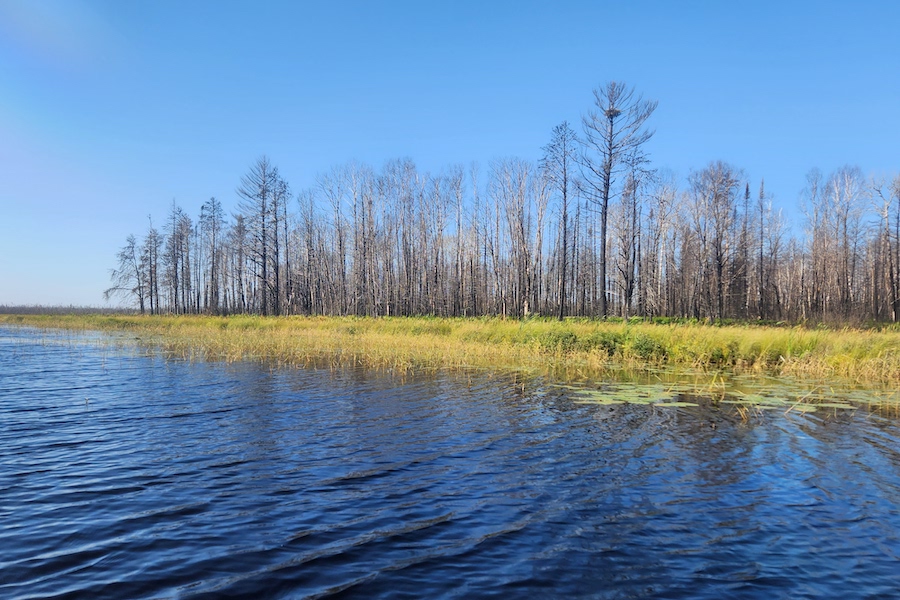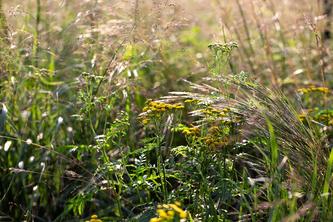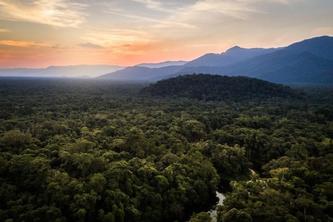
Warmer temperatures and increasing drought severity associated with climate change are contributing to more frequent and more severe wildfires across North America.
While attention to wildfires is commonly focused on California and the western U.S., forested regions of the Upper Midwest, including Minnesota, are maintained through well-documented fire regimes. As these fire regimes shift with climate change, there is limited knowledge of how direct wildfire burns within watersheds affect lake water quality, including which lakes are most sensitive to wildfires and what wildfire characteristics lead to the largest water quality impacts.
New research from the Natural Resources Research Institute (NRRI) at the University of Minnesota Duluth, recently published in the journal Geophysical Research Letters, finds that lakes in burned watersheds had higher nutrient (nitrogen and phosphorus), dissolved organic carbon and total suspended solids concentrations, as well as reduced water clarity and pH, compared to control lakes.
"As wildfires become more frequent and more severe under climate change, they may become an important stressor leading to water quality impairments and reduced ecosystem services, such as fisheries, in our prized, forested lakes," said Chris Filstrup, an applied limnologist at NRRI and co-author of the study. "These remote forested lakes are removed from direct human impacts within their watersheds compared to other lakes in the state, so they may be particularly susceptible to impacts of climate change, including increased wildfire regimes.”
The research team used the Greenwood Fire near Isabella, Minnesota, which was the 9th largest wildfire in Minnesota since 1984, as a case study. The Greenwood Fire burned 108 square kilometers of Superior National Forest from August 15 through September 2021, after being ignited by a lightning strike.
They sampled 30 total lakes monthly from May through September 2022, with 15 lakes being located in burned watersheds and 15 lakes being located in nearby, unimpacted lakes (control group). Burned and control lakes included both drainage and isolated lakes, and burned lakes varied in the amount of watershed burned and wildfire severity.
Water samples were collected from the deepest location in each lake as integrated surface mixed layer samples. Water samples were analyzed for nutrients (total nitrogen and total phosphorus), dissolved organic carbon, total suspended solids, water clarity, chlorophyll a (measure of algae biomass), pH, and temperature.
The study found that:
- Increased nutrient concentrations in burned lakes did not lead to increased algae biomass, potentially due to reduced light availability.
- Water quality responses in burned lakes were often cumulative or persisted throughout the summer, especially for drainage lakes which received tributary inflows from burned watersheds.
- Water quality impacts were greatest in lakes when wildfires burned shoreline areas and when wildfires were of high severity. For example, phosphorus concentrations increased with increasing proportions of high severity burns within the watershed.
- Among water quality variables, wildfire characteristics explained the most variation in total phosphorus, with the proportion of shorelines burned at high severity explaining more variation in total phosphorus (39.6%) than other lake and watershed variables.
"We were surprised that we did not see an increase in algae biomass in burned lakes caused by excess nutrient concentrations in these lakes," said Filstrup. "We do not know how long light limitation will continue to suppress algae biomass in these lakes, or if changes in underwater nutrient and light regimes will contribute to shifts in algae communities."
According to Filstrup, the findings suggest lakes with wildfire burns along the shoreline or lakes within high severity burn zones are the most susceptible to water quality impairments from wildfires, and should be increasingly monitored post-wildfires to document impacts.
Consequences of climate change, including increasing wildfire regimes, will continue to modify how aquatic ecosystems function, so scientists and natural resources managers will need to continue to work together to adapt previous management strategies to meet the challenges of these new realities.
"We're working with our agency partners to identify how our findings can contribute to targeted, post-wildfire monitoring strategies to assess wildfire impacts on lake health and provisioning of ecosystem services, as well as how they can be used to help inform forestry management practices and fuel reduction strategies near sensitive lakes,” said Filstrup.
For future studies, Filstrup added the findings demonstrate how lakes respond to wildfire disturbances in the short-term, but the sustained, long-term impacts of wildfire burns on lake water quality are poorly understood. Additionally, it is unclear how wildfires directly (through increased erosion and runoff) and indirectly (through changes in water quality) impact biogeochemical rates in burned lakes, including contaminants such as mercury and methyl mercury.
Funding for the study was provided by the National Science Foundation’s Division of Environmental Biology.
-30-
- Categories:
- Agriculture and Environment
- Climate Change
- Forestry





